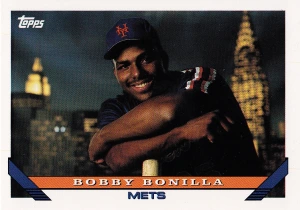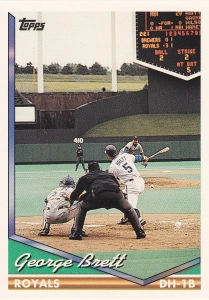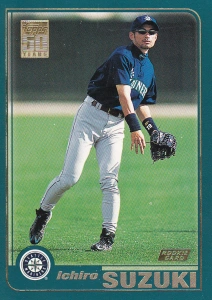Just the stats here – I’m doing the master set post tomorrow. This was the largest Topps set ever issued at 825 cards.
Info about my set:
How I put the set together:
- 307 cards from the series 1 wax box
- 345 cards from the series 2 wax box
- 16 cards I found I already had previously at my parents’ house
- 1 card from a card show
- 156 cards from trades
Card that completed my set: #630 – Mark Grace. One of 3 cards received in a trade with Nolan’s Dugout that completed the set. Kyle also provided the final card for the ’92 set.

Set composition: 825 cards (713 individual player cards*, 26 Coming Attractions, 10 4-player Top Prospects, 16 2-player expansion prospects, 28 draft picks, 14 Managers, 11 All-Stars, 6 checklists, 1 “Russians Angels”)
*The 713 individual player cards include 10 All-Star Rookies
Representation of ’92 MLB season: There are 5 players featured on two regular cards in the set as they are shown in a Rockies or Marlins uniform in series 2. None of the players from the Expansion prospects made the big leagues in 1992, and none of the 3 “Russian Angels” ever made the majors. There were 18 other Marlins & Rockies throughout series 2 who didn’t play in 1992. 6 of the Top Prospects, 20 of the Coming Attractions did in fact make the bigs in ’92, and 1 Draft Pick subset did make the majors (Jeff Granger).
So, if you do all that math from above, that leaves 716 different players on cards in 1993 Topps. Of those remaining players, there were 5 guys with “regular” cards who didn’t play in 1992 as well. Youngsters Chris George (Brewers), Todd Van Poppel (A’s), Jeff Juden (Astros) and Kevin Flora (Angels) all played briefly in 1991 but didn’t get a cup of coffee in 1992. And Bo Jackson had a card despite being out all of 1992 recovering from hip replacement surgery. The 711 players represent 70.6% out of the ~1,007 players who played in MLB in 1992.
Last active player from this set: #98 – Derek Jeter (rated #20 in Topps vote of 60 best cards)

Jeter is the only player still active who is in this set.
Technically, he’s on the DL and his last game was game 1 of the ALDS last year. This would still have him beating out Jim Thome by about 3 days as the last active player. In addition to Jeter and Thome, Chipper Jones and Omar Vizquel are in this set. All 4 of these guys played their last regular season game on 10/3/12, though Jeter will make that a moot point soon.
Player with the most cards in the set: 27 players with 2 cards in the set. The 22 players featured on the All-Star cards and then 5 players mentioned above with both a series 1 and series 2 regular card.
Topps started going with a lot more draft pick and prospect cards in 1993, removing the more traditional subsets in the process.
First Card and the Hundreds: #1 – Robin Yount, #100 – Mark McGwire, #200 – Kirby Puckett, #300 – Cal Ripken, #400 – Bo Jackson, #500 – Jose Canseco, #600 – Bret Saberhagen, #700 – Nolan Ryan, #800 – Shawn Jeter

Highest book value: #98 – Derek Jeter DP RC (see above)
Most notable card: #98 – Derek Jeter DP RC (see above)
Like Manny the year before, this is easily the most notable card in this set. And, as the only noteworthy rookie card (sorry Jim Edmonds), Jeter easily carries the highest “book value”.
Best card (my opinion): #52 – Bobby Bonilla

I imagine this is a card where there could be quite a bit of disagreement. And to each his own. This doesn’t feature a baseball action shot, or even a pose in an actual baseball environment. Bonilla (and Bonds a year later) were such big free agent signings. They felt like the first really huge free agent moves in baseball history. At some level, they were, because Bonilla signed the largest contract ever in 1992 when he left Pittsburgh for the Mets. Bonds passed him the next year when he left for the Giants.
Anyways, like him or not and question his tenure in New York, I think this card captures a bit of baseball history in a unique way. And New York City has always held a special allure to me.
Second best card (also my opinion): #200 – Kirby Puckett

Another card with a contrived photo. But that’s ok – it’s another cool contrived photo. This card, featuring Puckett posing with a giant baseball bat, was actually the same photo that Sports Illustrated used when it put Puckett on the front cover of its 1992 baseball preview issue.
Best subset card: #409 – Greg Maddux / Roger Clemens AS

Tom Glavine and Kevin Brown were the actual starters from the 1992 All-Star game, but that’s OK. This card captures (arguably) the 2 greatest pitchers of our lifetime. Of course, you didn’t know that then that they would win a combined 709 games and 11 Cy Young awards, but it’s cool they were both on this same card.
Favorite action photo: #50 – Roberto Alomar

This card is pure awesome. The dust settling. Carlos Baerga sliding into second to break up the potential double play. Alomar (who would someday take that spot at second base Baerga held in Cleveland) looking on after the throw, mid-air with his leg kicked up. Mel Harder’s retired number in the background at old Municipal Stadium. I won’t lie, I had to look up who the hell Mel Harder was, bujt it’s still cool. He won over 220 games, by the way.
The McGwire (show above as it’s card #100) and Gary Carter’s card, which shows a play at the plate with Fred McGriff, are also some pretty good action shots I considered.
Favorite non-action photo: #52 – Bonilla (see above)
Best card overall, and best pose to me. Just beating out that Puckett.
My Favorite Reds card: #515 – Greg Swindell

Swindell had a pretty decent year with the Reds during his lone season in Cincinnati in 1992. This is a cool photo. Beats out a pretty good card of Tom Browning.
Topps Reprints and others:
- 1999 Ryan reprints – Nolan Ryan
- 2001 Through the Years – Derek Jeter
- 2001 Archives – Gary Carter, Bert Blyleven, Jack Clark, Carlton Fisk, Dale Murphy, Frank Tanana
- 2001 Archives Rookie Reprints – Jeter, Jim Edmonds, Preston Wilson
- 2001 Topps Traded – Mike Piazza (’93T), Barry Bonds (’93T)
- 2002 Archives – Lenny Dykstra
- 2002 Archives Reprints – Mike Piazza, Pedro Martinez
- 2002 Gallery Heritage – Bret Boone, Mike Piazza (just his part of the card), Martinez
- 2003 Gallery Heritage – Jeter
- 2005 Rookie Cup Reprints – Eric Karros, Jeff Kent, Kenny Lofton, Moises Alou, Reggie Sanders
- 2010 CMT – Jeter, Ozzie Smith, Frank Thomas
- 2011 60YOT – Edmonds, Craig Biggio
- 2013 Rookie Card Patch – Jeter
Jeter comes in with 5 reprints, 3 more than Edmonds, Martinez and (sort of) Piazza’s quad player prospect card.
Other Notable Cards: The big thing with this set was that series 2 featured over 60 players dressed in Rockies and Marlins uniforms. It certainly seemed like there were 2 or 3 in every pack. Some would have 2 guys per pack – like the first two players signed for each team – Clemente Nunez for the Marlins and Ryan Turner. David Nied and Nigel Wilson were their first picks from other teams in the expansion draft. Charles Johnson and John Burke were their first round picks from 1992 – but neither has a card in this set for some reason.




































































